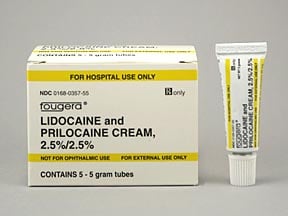
Lidocaine-prilocaine Coupons & Savings Card – Discount Prices from $2.96
Generic for: Livixil pak, Relador pak, Relador pak plus
My prescription
Edit
1GM of 2.5-2.5%, Lidocaine-prilocaine (1 Tube)
Select pharmacy

CVS
$18.11
COUPON PRICE
Walmart
$2.96
COUPON PRICE
Albertsons
$3.90
COUPON PRICE
Walgreens
$4.03
COUPON PRICEFree Lidocaine-prilocaine Savings Card

Walmart
$2.96
Show this coupon to your pharmacist
ID
LHE64372C7
PCN
CHIPPO
BIN
019876
GRP
LHX
This coupon is not insurance
More prescriptions for pain
More prescriptions for pain
Price history for Anodyne Lpt (brand) & Lidocaine-prilocaine (generic)
1 Tube, 1GM of 2.5-2.5%
Average retail price for Anodyne Lpt
Average retail price for Lidocaine-prilocaine
Average SaveHealth price for Lidocaine-prilocaine
Our price history data is based on aggregated prescription data collected from participating pharmacies in America. Our prescription data updates daily to reflect the latest price changes. If you notice a missing data point, it means there wasn't sufficient data available to generate a monetary value for that date.
We analyzed Lidocaine-prilocaine prices for (1GM of 2.5-2.5%, 1 Tube) over the last 12 months. The average retail price was $18.33, while the average price using the SaveHealth discount card was $3.67. That's a savings of approximately 79.98% when using our Lidocaine-prilocaine coupon.
Compared to the generic version, Anodyne Lpt had an average price of $1765.82 over the same time period. With the SaveHealth savings card, Lidocaine-prilocaine is 99.79% cheaper on average than Anodyne Lpt.
*Retail prices are based on pharmacy claims data, and may not be accurate when we don't have enough claims.
Lidocaine-prilocaine dosage forms
Dosage Quantity Price from Per unit 1GM of 2.5-2.5% 1 Tube $2.96 $2.96 1GM of 2.5-2.5% 2 Tubes $3.42 $1.71 1GM of 2.5-2.5% 3 Tubes $3.88 $1.29
| Dosage | Quantity | Price from | Per unit |
|---|---|---|---|
| 1GM of 2.5-2.5% | 1 Tube | $2.96 | $2.96 |
| 1GM of 2.5-2.5% | 2 Tubes | $3.42 | $1.71 |
| 1GM of 2.5-2.5% | 3 Tubes | $3.88 | $1.29 |
Lidocaine-prilocaine Warnings
The following information outlines essential safety warnings and precautions for using lidocaine/prilocaine. Please read carefully and consult your healthcare provider with any concerns.
Overdose Risks: Applying lidocaine/prilocaine over large skin areas or for prolonged periods can lead to excessive absorption, especially in individuals with severe liver disease. This may result in severe side effects such as seizures or breathing difficulties. Older adults and those who are frail or severely ill may be more susceptible. Use the medication strictly as prescribed.
Heart Rate or Rhythm Changes: When used alongside certain heart medications, such as amiodarone or sotalol, lidocaine/prilocaine can affect heart rate or rhythm due to additive effects. Inform your healthcare provider if you are on heart medications to determine if monitoring is necessary.
Methemoglobinemia Risk: Some users may develop methemoglobinemia, a serious condition where the blood's ability to carry oxygen is reduced. Symptoms include skin discoloration, seizures, and changes in heart rhythm. Those with G6PD deficiency, heart or lung issues, or those taking oxidizing agents (like benzocaine or dapsone) should notify their provider. Seek immediate medical attention if you notice any symptoms such as pale or blue skin, headaches, or shortness of breath.
Application Restrictions: Do not apply lidocaine/prilocaine to the ears as it may cause auditory or balance issues. Only use the medication on the skin as directed.
Remember to use lidocaine/prilocaine exactly as directed by your healthcare provider to minimize risks and ensure safety.
Lidocaine-prilocaine Side Effects
Common side effects:
- skin redness
- paleness
- burning sensation
- swelling
- changes in temperature sensations
- itching
- rash
Less common but important to monitor:
- lightheadedness
- nervousness
- feelings of excitement
- confusion
- dizziness
- drowsiness
- ringing in the ears
- blurred or double vision
- vomiting
- twitching
- tremors
- seizures
Serious side effects:
- unconsciousness
- shallow breathing
- trouble breathing
- swelling
- low blood pressure
- rash
- methemoglobinemia
- blue or gray skin color
- seizures
- coma
- changes in heart rate or rhythm
Lidocaine-prilocaine Interactions
Lidocaine and prilocaine are local anesthetics commonly used together to numb the skin before medical procedures. While effective, their combined use can lead to certain drug interactions and side effects that patients should be aware of.
One significant concern is the risk of methemoglobinemia, a condition where the blood's ability to carry oxygen is reduced. This risk increases when lidocaine and prilocaine are used together, especially in individuals who are very young (particularly infants), or those with conditions such as anemia, heart or lung diseases, blood circulation disorders, liver cirrhosis, shock, sepsis, or certain genetic traits like NADH cytochrome-b5 reductase deficiency, glucose-6-phosphate dehydrogenase deficiency, and hemoglobin M. Symptoms of methemoglobinemia may include gray or blue-colored skin, lips, or nail beds; headache; dizziness; fatigue; shortness of breath; rapid heart rate; and confusion. If any of these symptoms occur, seek immediate medical attention.
Additionally, using lidocaine and prilocaine with other medications can lead to interactions. For instance, combining these anesthetics with certain heart rhythm medications (like Amiodarone, bretylium, Sotalol, or Dofetilide) may increase the risk of heart-related side effects. Also, prilocaine can contribute to methemoglobinemia when used with other drugs known to cause this condition, such as certain antibiotics (like Dapsone or Nitrofurantoin), antimalarials (like chloroquine or Primaquine), and other local anesthetics.
It's important to inform your healthcare provider about all medications, supplements, and herbal products you are currently using before starting treatment with lidocaine and prilocaine. This will help prevent potential interactions and ensure the safe use of these anesthetics.
